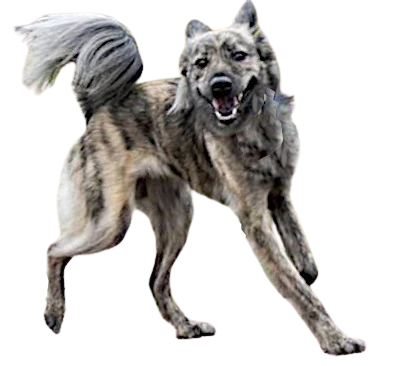Taiwanese Mountain Dog: An Ancestral Canine Treasure
The Taiwan Mountain Dog (Canis lupus chanco) is a canid known for its robustness and adaptation to mountainous environments. This dog is primarily found in the mountainous regions of Taiwan.
Physical Description of the Dog
The Taiwan Mountain Dog is distinguished by its dense and thick coat, often gray or brown in color. It stands about 50 to 60 cm tall at the withers and weighs between 15 and 25 kg. Its tail is bushy and often curled over its back.
Classification
The Taiwan Mountain Dog belongs to the Canidae family.
- Kingdom: Animalia (Animals)
- Phylum: Chordata (Chordates)
- Class: Mammalia (Mammals)
- Order: Carnivora (Carnivores)
- Family: Canidae (Canids)
- Genus: Canis
- Species: Canis lupus chanco
This dog is one of the species best adapted to the mountainous environments of Taiwan.
Habitat
The Taiwan Mountain Dog is extremely adaptable and can be found in a wide range of mountainous habitats: mountain forests, alpine meadows, and rocky areas. Its ability to adapt to harsh conditions allows it to survive in hostile environments.
Behavior and Social Life
This canid is primarily solitary but can form family groups during the breeding season. Active mainly at dusk and dawn, the Taiwan Mountain Dog is an opportunistic hunter, using its keen sense of smell and hearing to locate prey.
Diet
Carnivorous, the Taiwan Mountain Dog feeds on a variety of prey: small mammals, birds, and sometimes carrion. In mountainous environments, it can also consume plants and berries. This diverse diet illustrates its ability to thrive in difficult environments.
Conservation
Although the Taiwan Mountain Dog is not endangered, it faces threats such as hunting, diseases, and habitat loss. Its reputation as a pest can also lead to persecution.
Closest Genetic Relatives
The Taiwan Mountain Dog belongs to the genus Canis, which also includes the Gray Wolf (Canis lupus). These two species share unique characteristics within the Canid family, particularly their ability to adapt to diverse environments.
-
The Gray Wolf is widely distributed across the world, including North America, Europe, and Asia. It is known for its ability to form packs and hunt cooperatively. This species is also threatened by habitat loss and conflicts with humans.
-
The New Guinea Singing Dog (Canis hallstromi) is another close relative. Though rare and primarily found in the wild in the mountains of New Guinea, this species exhibits distinctive vocal behaviors and a strong resemblance to the Taiwan Mountain Dog. Both share complex social structures and an ability to survive in challenging environments.
-
The Australian Dingo (Canis dingo) is also a notable genetic cousin. Native to Australia, the Dingo has evolved to become an effective predator in varied ecosystems. Like the Taiwan Mountain Dog, it demonstrates remarkable adaptive traits, including the ability to live independently of humans while maintaining occasional interactions with them.
Tips for Observers
To observe the Taiwan Mountain Dog in its natural habitat, follow these tips:
- Observe at dusk: The dog is more active at sunrise and sunset.
- Stay still: Keep your distance to avoid frightening the animal.
- Choose quiet areas: Look for places where the dogs are known to frequent.
- Bring binoculars: This will allow you to observe the animals at a safe distance and better appreciate their behavior.
- Dress discreetly: Wear neutral-colored clothing to blend into the environment and avoid attracting attention.
- Avoid loud noises: Walk softly and speak quietly to avoid alarming the local wildlife.
By following these recommendations, you can admire this fascinating animal while minimizing disturbances. Don't forget to bring a camera to capture the experience, while remaining discreet.
The Taiwan Mountain Dog is an emblematic species of resilience and adaptability. Its preservation depends on harmonious coexistence between humans and wildlife.
Wild Dog Breeds
© 2023 touslestoutous.com − All doggies. All rights reserved.
"The data available on this site may be used provided that the source is duly acknowledged."
